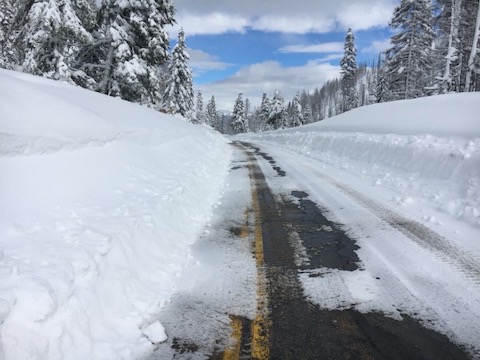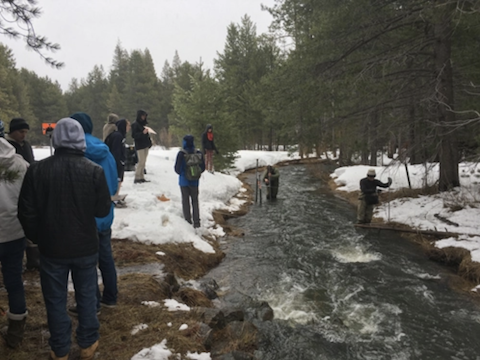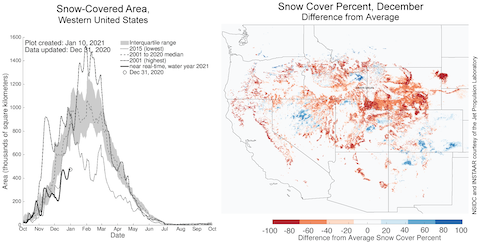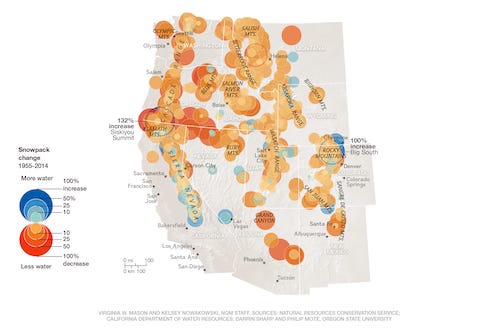
If you live in or visit the mountains, you can look at the snow-covered hills as nature’s water towers. As that snow melts, it could provide 75 percent or more of the area’s freshwater each year.
That’s true far downstream from the mountains too, and even in snowy flat areas. Around the world, snow provides 50 percent of our total annual freshwater supply.
And it does more than that: snow reflects sunlight, keeping areas cooler and making it possible for snow to accumulate.
Snow protects against erosion, slowly melting and deeply recharging the soil with water–preventing it from leaving the area as runoff.
Melting snow gradually fills streams, which slowly fill rivers, providing a steady supply of freshwater that can last through summer.
Warmer winters are disrupting this process though.
So-called ‘dry snow droughts’—as we’ve seen in California’s Sierra Nevada—sometimes with just 5 percent of normal snowfall, have led to water shortages for the region’s growing cities.
Warm snow droughts, where precipitation falls as rain—as we’ve seen in the Pacific Northwest—melt the snowpack early, causing heavy streamflow and even floods in winter and early spring, again depriving communities and agriculture of water later in the year.
So, whether you’re a ski bum or someone who works in the billion-dollar winter recreation industry, a fisherman or a farmer, or just a city dweller who drinks water, we should all hope for cold, snowy winters.
Background
Synopsis: If you like winter, you probably love the fun that snow brings. But snow isn’t just for fun. Snowpack is a vital resource for many regions of the world. Snowmelt supplies half the world’s freshwater each year, and in the arid American West that proportion increases to 75%. But snowpack is becoming less predictable as Earth warms, putting the principal water supply for billions at risk.
- Why is snow important?
- Bright white snow reflects sunlight, regulating climate and keeping entire regions cool.
- Snowmelt keeps soil moist and protects forests from wildfires. It replenishes natural aquifers as well as man-made reservoirs.
- Snowpack supports entire ecosystems as meltwater rushes from mountain streams to rivers, lakes, and coastal areas.
- Snow is essential to the multibillion-dollar winter recreation industry.
- Perhaps most importantly, snow is a vital source of freshwater on Earth—each year, 50% of Earth’s freshwater starts as snowfall.

- Mountains are nature’s water towers.
- Mountains are islands of moisture, driving the weather around them with their topography. Mountains in colder climates have frequent winter snowstorms.
- Snowpack accumulates in winter and melts slowly through the spring and summer, delivering water downstream at a manageable rate when it is most needed to support agriculture and forests.
- Snowmelt forms the headwaters that feed streams, rivers, lakes, and aquifers on their way to the sea.
- From North America’s Rockies to South America’s Andes to Europe’s Alps and Asia’s Himalayas, mountain snow is the ultimate source of water for billions of people in the highlands and lowlands alike.
- Snowmelt runoff depends on a variety of aspects that vary year by year.
- Snow accumulates in the winter, with its volume reliant on factors like weather patterns, storm frequency, humidity, air temperature, and vegetation.
- The volume of snowfall captured in an area ultimately controls the amount of annual recharge within its watershed.
- Depending on the temperature and humidity when it falls, snow may be wet or dry. Wet snow may contain 50% more water than the same volume of dry snow.
- The saturation of the soil below the snow during the previous fall and early winter influences how much snowmelt percolates into the ground during the spring thaw before surface runoff begins.
- Air temperature and spring precipitation dictate the pace of the thaw in spring and summer.
- Populations in the western United States are more dependent than most on snowpack as a water source: 75% of their fresh water starts as snowpack.
- The proportion of precipitation that falls as snow is important in the American West because snowpack slowly and predictably releases water downstream throughout the summer.
- More than 700 reservoirs capture water in the region to make it habitable for populations in cities like Las Vegas, Phoenix, Los Angeles, and Denver, and to make agriculture possible in places like California’s fertile Central Valley.
- In the United States, snowpack has been measured for decades at more than 850 sites using everything from automated gauges to manual readings taken by intrepid individuals on snowshoes.
- Readings are taken annually on what has traditionally been the peak date for water content in snowpack: April 1.
- Snow water equivalent (SWE) data are reported on interactive sites like SWE Interactive Map | USDA and Snow Today | NSIDC.
- SWE data data and remote sensing available from a variety of satellite networks have revealed some concerning trends.

- The recent trend of warming winters is changing historical trends for snowpack in the western U.S.
- The annual number of snowstorms is decreasing, and the area covered by snow each year is declining.
- As regions warm earlier, snow melts earlier. With the snow melting earlier, snowmelt dwindles in the summer when crops and wetlands need it most, resulting in repetitive and deepening droughts throughout the watershed.
- Without snow’s reflective white surface, solar energy is no longer reflected into space, further warming the ground.
- More winter precipitation arrives as rain, melting even more snowpack and bringing spring flood risks.

- Snow droughts are periods of unusually low snowpack for a particular time of year, resulting in lower-than-normal snow water equivalent. There are two types of snow drought, each requiring very different water management strategies.
- “Dry” snow droughts are driven by an overall deficit of precipitation, resulting in less water being delivered to a region as either snow or rain.
- Dry snow droughts typically have low streamflows in winter, spring, and summer, so water managers hold as much water as they can in upstream reservoirs to make it available to local communities later in the year.
- In 2015, the Sierra Nevada received just 5–50% of its normal precipitation: a dry snow drought.
- “Warm” snow droughts are caused by above average temperatures, even if the overall precipitation is near normal.
- During a warm snow drought, water managers must walk a fine line between letting some large water flows pass downstream—maintaining enough space in their reservoirs to control dangerous early season floods—while still storing enough water to mitigate summer droughts.
- In the winter of 2015, the Pacific Northwest was about 5.5°F (3°C) warmer than usual, causing late-winter precipitation to fall as rain, further accentuating the ongoing early snowmelt. This shifted the timing of runoff to high streamflows in the winter, depriving the area of snowmelt that normally would have been available in the spring and summer for agriculture: a warm snow drought.
- “Dry” snow droughts are driven by an overall deficit of precipitation, resulting in less water being delivered to a region as either snow or rain.
- Warming temperatures are driving earlier melting, which is shifting the maximum snowpack snow water equivalent (SWE) from the historical date of April 1 into March or even February.
- This warming threatens to upend the multibillion-dollar winter recreation industry, and the mismatch between snowmelt availability and agricultural need could cause trillions of dollars of impact.

